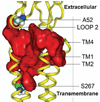Molecular targets and mechanisms for ethanol action in glycine receptors
- PMID: 20399807
- PMCID: PMC2891126
- DOI: 10.1016/j.pharmthera.2010.03.003
Molecular targets and mechanisms for ethanol action in glycine receptors
Abstract
Glycine receptors (GlyRs) are recognized as the primary mediators of neuronal inhibition in the spinal cord, brain stem and higher brain regions known to be sensitive to ethanol. Building evidence supports the notion that ethanol acting on GlyRs causes at least a subset of its behavioral effects and may be involved in modulating ethanol intake. For over two decades, GlyRs have been studied at the molecular level as targets for ethanol action. Despite the advances in understanding the effects of ethanol in vivo and in vitro, the precise molecular sites and mechanisms of action for ethanol in ligand-gated ion channels in general, and in GlyRs specifically, are just now starting to become understood. The present review focuses on advances in our knowledge produced by using molecular biology, pressure antagonism, electrophysiology and molecular modeling strategies over the last two decades to probe, identify and model the initial molecular sites and mechanisms of ethanol action in GlyRs. The molecular targets on the GlyR are covered on a global perspective, which includes the intracellular, transmembrane and extracellular domains. The latter has received increasing attention in recent years. Recent molecular models of the sites of ethanol action in GlyRs and their implications to our understanding of possible mechanism of ethanol action and novel targets for drug development in GlyRs are discussed.
(c) 2010 Elsevier Inc. All rights reserved.
Figures



References
-
- Aguayo LG, Pancetti FC. Ethanol Modulation of the γ-Aminobutyric AcidA and Glycine-Activated Cl− Current in Cultured Mouse Neurons. J Pharmacol Exp Ther. 1994;270:61–69. - PubMed
-
- Alkana RL, Boone DC, Finn DA. Temperature Dependence of Ethanol Depression: Linear Models in Male and Female Mice. Pharmacol Biochem Behav. 1985;23:309–316. - PubMed
-
- Alkana RL, Davies DL, Morland J, Parker ES, Bejanian M. Low Level Hyperbaric Exposure Antagonizes Locomotor Effects of Ethanol and N-Propanol but Not Morphine in C57BL Mice. Alcohol Clin Exp Res. 1995;19:693–700. - PubMed
-
- Alkana RL, Finn DA, Bejanian M, Crabbe JC. Genetically Determined Differences in Ethanol Sensitivity Influenced by Body Temperature During Intoxication. Life Sci. 1988;43:1973–1982. - PubMed
Publication types
MeSH terms
Substances
Grants and funding
LinkOut - more resources
Full Text Sources
Molecular Biology Databases

